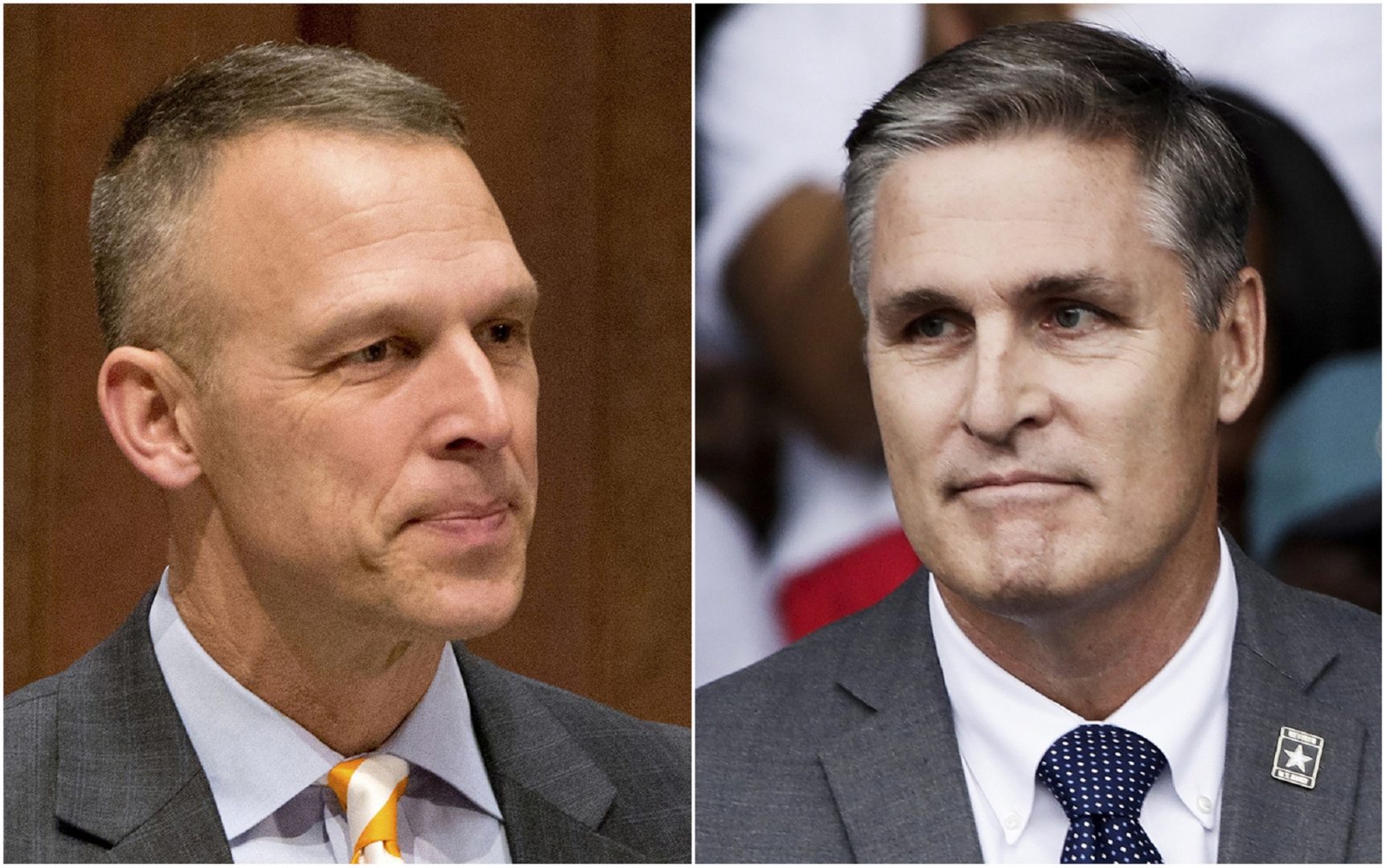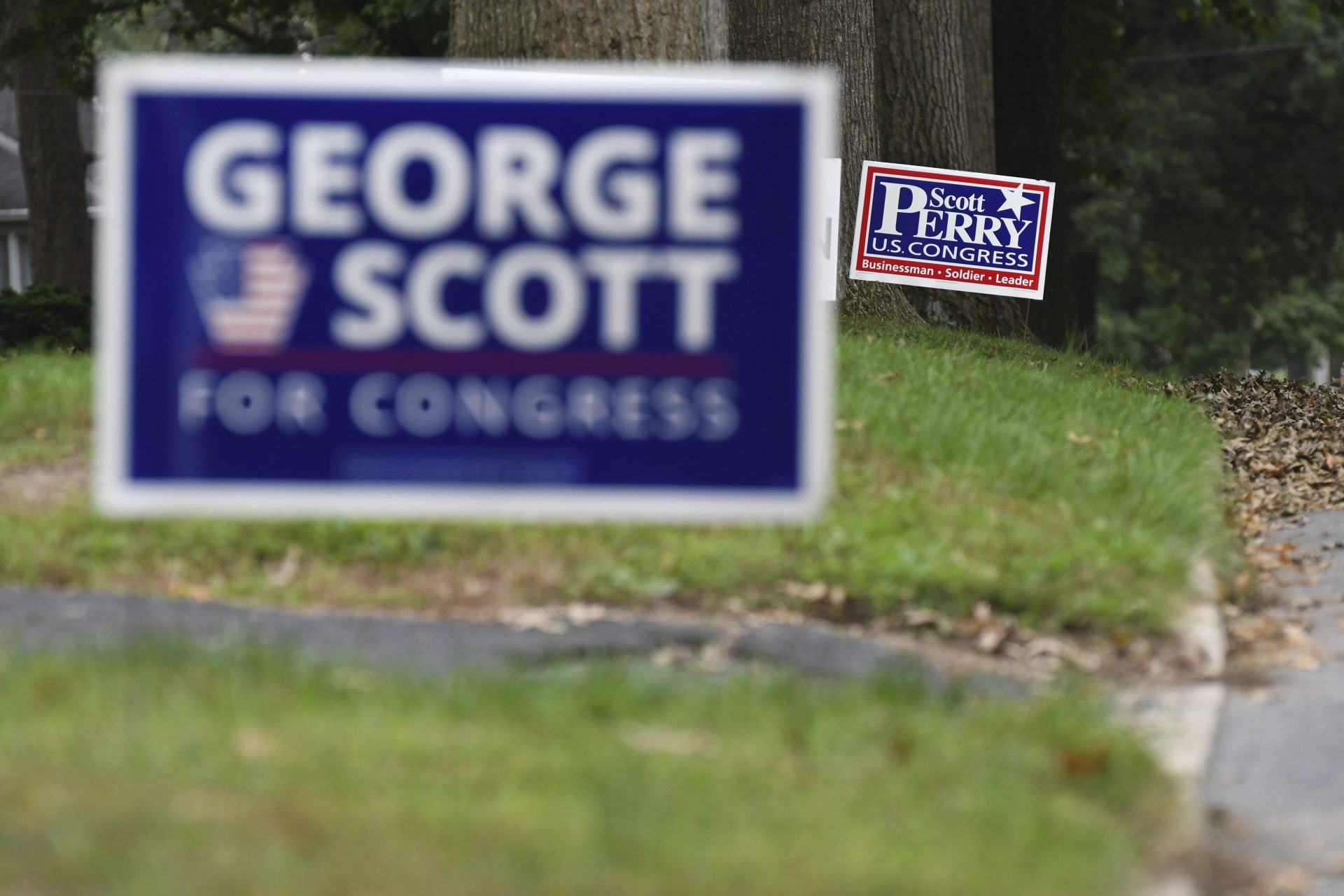
This combination of photos shows congressional candidates Rep. Scott Perry, R-Pa., left, and Democrat challenger George Scott.
Photo by The Associated Press

This combination of photos shows congressional candidates Rep. Scott Perry, R-Pa., left, and Democrat challenger George Scott.
Photo by The Associated Press

Photo by The Associated Press
This combination of photos shows congressional candidates Rep. Scott Perry, R-Pa., left, and Democrat challenger George Scott.
(Undated) — Organizers weren’t sure, initially, whether U.S. Rep. Scott Perry, R-10, would appear in-person for the Cumberland 9/12 Patriots’ candidates forum in Carlisle last spring.
After all, the 10th District Republican primary was uncontested.
And that’s not unusual for Perry. He’s run unopposed — literally or for practical purposes — since his first bid more than a decade ago: a five-way primary for the state House seat being vacated by longtime Rep. Brian Smith, R-Dillsburg, after the legislative payraise scandal in which lawmakers increased their salaries with a surreptitious late-night vote.
Perry served two terms at the state Capitol and is now going for his fourth term in the U.S. House of Representatives. In each congressional victory, he’s captured between 60 and 75 percent of votes.
That night last spring, Perry ended up being there, relaxed and smiling. He didn’t face tough questions – or any at all. He ran through his personal statement and gave open-ended explanation of his key positions, eliciting applause and laughter from the crowd at times. His time on stage concluded with the moderator complimenting a photo of Perry taken with President Donald Trump on Air Force One.
At this point, the congressional map had already been redrawn. But the new 10th was still considered red.
Most assessments are based mainly on presidential returns, and these precincts would’ve picked President Donald Trump if they’d been grouped together in 2016 and, according to our analysis, a Republican for Congress by an even wider margin.
Registered Republicans do outnumber Democrats by 22,000 voters. But about three times as many people are registered as unaffiliated or with third parties according to our analysis of the latest registration numbers from the Department of State.
Perry still has an edge. But the margins are slim enough (between one and five points, depending on when and which poll) that the tenth’s now considered too close to call and expected to be the GOP’s toughest battle of Pennsylvania districts where they retain an advantage.

Marc Levy/The Associated Press
Campaign signs for Republican U.S. Rep. Scott Perry of Pennsylvania and Democratic challenger George Scott as seen on a neighborhood street in the district, Saturday, Oct. 6, 2018 in Camp Hill.
And so, the congressman’s got his game face on.
His challenger is Democrat George Scott, a Lutheran pastor who lives seven miles from Perry in York County. Scott, a retired Army intelligence officer, hasn’t run for office before, so he doesn’t have a voting record to scrutinize, or gaffes to recall, like Perry does (as incumbents always do).
“My opponent, he has no record on the things that he has talked about. He’s been inconsistent, and … no one’s been able to, no one’s been willing to, call him on it,” Perry said one night after the pair appeared at a forum at the JCC in downtown Harrisburg. “Except for me.”
The race is close enough that Vice-President Mike Pence flew in to stump for Perry and incumbent U.S. Rep. Lloyd Smucker, who’s in his own dead heat in the 11th district.
Meanwhile, Scott’s pivoted from primary mode, when he was appealing to more liberal voters. He ran, for example, a commercial in which he tossed an AR-15 rifle into an open fire. (His campaign has long since pulled the ad.)
Former Republican state lawmakers Steve Nickol from York County and Pat Vance, who’s from Dauphin County and served 26 years in the legislature, have endorsed Scott, despite supporting and serving in the statehouse with Perry in the past. Also, former Vice-President Joe Biden’s coming to town this weekend to stump for Scott.
And Scott’s outspent and out-fundraised Perry in terms of both direct campaign contributions and support from political action committees, although the incumbent has more cash on hand, according to the most recent Federal Election Commission reports.
There are striking personal similarities between the candidates: born and raised in rural south central Pennsylvania, military careers, devout Christians, proud hunters and gun owners. Although Perry’s described a decidedly more disadvantaged upbringing (his father was absent or abusive, his mother worked multiple jobs and as a kid, Perry says, he found solace and purpose in the difficult work of picking fruit).
On the issues, the differences between the candidates are stark: Perry wants to build a wall on the U.S.-Mexico border; Scott doesn’t. Perry’s OK with tariffs put in place this year because of what he sees as their potential long-term benefits; Scott isn’t. Scott wants the minimum wage increased gradually to $15 an hour and then indexed to inflation; Perry thinks states should pick their own rate and isn’t in favor of raising it, in general. It’s much the same with healthcare, gun control and other issues.
Then there’s voter enthusiasm. Turnout for the midterm primary this year was its typical low rate. But it might be higher than usual for the general election if registration and early and absentee voting are any indication.
Harvey Freedenberg, who’s 67 and spent most of his life in the Harrisburg area, has been volunteering on political campaigns for decades. Right now, he’s helping out Scott, and we talked to him while he was cold-calling constituents at campaign headquarters in a rented small office building on the riverfront in downtown Harrisburg.
(Perry’s campaign declined to provide details about his campaign schedule or afford comparable access).
Freendenberg says the most consistent difference between conversations with prospective voters this year and past years have to do with logistical issues stemming from the changes to Pennsylvania’s congressional district map.
“Some people are still not aware that they’re living in a new congressional district,” Freedenberg said. “So, there’s that education process that you don’t have in a normal campaign.”
The tenth congressional district consists of Dauphin County and parts of York and Cumberland counties.

Sometimes, your mornings are just too busy to catch the news beyond a headline or two. Don’t worry. The Morning Agenda has got your back. Each weekday morning, host Tim Lambert will keep you informed, amused, enlightened and up-to-date on what’s happening in central Pennsylvania and the rest of this great commonwealth.
The days of journalism’s one-way street of simply producing stories for the public have long been over. Now, it’s time to find better ways to interact with you and ensure we meet your high standards of what a credible media organization should be.